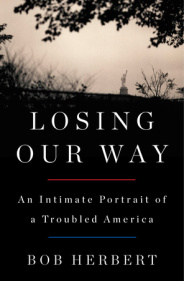The moment came unexpectedly, which is how denial is often pierced. Guntars Lakis, an architect in Bridgeport, Connecticut, had been watching his small kids at soccer practice. They came running toward him when practice was over, sweating, giggling and clamoring for Italian ices. That was when he realized how far he had fallen. In a lush, beautifully-landscaped suburban park, on a late afternoon in summer, he felt ashamed. “They wanted an Italian ice after practice,” he told me, “and I didn’t have four dollars in my wallet to buy it for them. I didn’t have any money at all.”
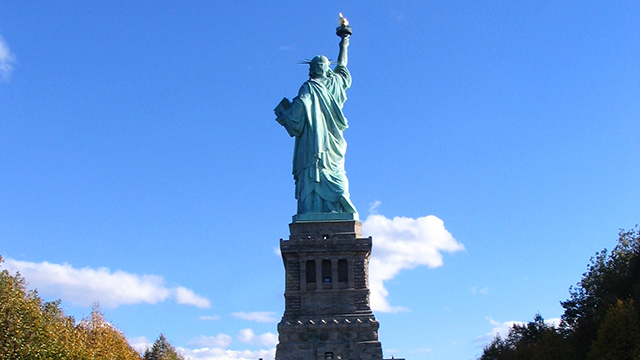
(Photo: National Park Service)
As I traveled the country doing research for this book, I couldn’t help but notice that something fundamental in the very character of the US had shifted. There was a sense of powerlessness and resignation among ordinary people that I hadn’t been used to seeing. The country seemed demoralized. I remembered the United States a far more confident and boisterous place in the days when I was growing up in suburban New Jersey in the 1950s and ’60s. Kids, grownups, everybody had their dreams and were unabashedly flexing their muscles, ready to make them come true. The bigger the dream the better. Each day was the dawn of new possibilities. All you needed was energy and a willingness to work hard.
That bold confidence in the future now seemed as old-fashioned as typewriters and telephone booths. There was still plenty to admire about the US, and crowds could be heard from time to time chanting “USA! USA!” at rallies and ballgames. But what I was seeing in my travels was a deeply wounded society, with a majority of respondents in poll after poll saying the US was in a state of decline. The symptoms were numerous, varied and scary. The economy seemed to work only for the very wealthy. By 2013 the richest one percent in America was hauling in nearly a quarter of the nation’s entire annual income and owned 40 percent of its wealth. The bottom 80 percent of Americans, 250 million people, were struggling to hold onto just seven percent of the nation’s wealth. No wonder people were demoralized.
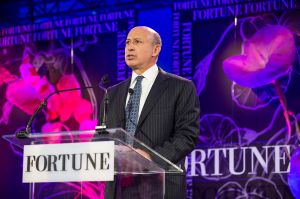
The head of Goldman Sachs Lloyd Blankfein at the 2012 Fortune Most Powerful Women conference to honor global women leaders. (Photograph: Stuart Isett/Fortune Most Powerful Women Summit/flickr CC 2.0)
The incomes of the uber-rich came to mind one winter morning as I was reading a desperate letter written by a woman in her mid-50s to Senator Bernie Sanders of Vermont. The woman and her husband were unemployed and about to lose their home to foreclosure. “I pray to God,” she wrote, “that we do not have to resort to living in the car which is unimaginable in the middle of January in zero degree temperatures with no gas money to run the engine to keep warm.”
For ordinary Americans, the story of the past several years has too often been about job cuts, falling wages, vanishing pensions and diminished expectations. Birth rates plummeted in the wake of the recession as couples put off having children for financial reasons. The lowest birth rates ever recorded in the US were in 2011 and 2012. By then, nearly one in every four American children was poor. For black children, it was one in three. The decline in births came as studies were showing alarming increases in mortality rates for some segments of the population. From 1990 to 2008 the life expectancy for the poorest, least well educated white Americans fell by a stunning four years. For white women without a high school diploma, it fell by five years.
One night, after I’d moderated a program on Afghanistan at the Kennedy Presidential Library in Boston, a World War II veteran came up to me and asked plaintively, “What happened to us?” His tone and weathered face conveyed a sense of real loss. He’d known a different America, having worked as an engineer and raised a family in the Midwest in the post-World War II period when the United States showed every sign that it was really getting its act together, becoming in actual fact a more perfect union. As we talked, I thought back to that era, which in many ways was a golden time. By the mid-1960s the warm glow of success was spreading like the summer sun to most of the country. The first of the baby boomers had put aside their Davy Crockett hats and Mickey Mouse Club ears and were entering college. Television was moving from black and white to color. Unemployment was low, wages and profits were high, and the nation’s wealth, compared to today, was distributed in a much more equitable fashion.
The nation was far from perfect and I would be the last person to suggest otherwise. There was plenty of conflict, small-mindedness and bigotry. Vietnam would prove an unmitigated disaster. Blacks and women had to mobilize to fend off treatment that was hideously and often criminally unjust. But there was also an openness to new ideas and a willingness to extend a collective hand to those who were struggling. It was a time in which the Supreme Court struck down one racist statute after another; a time that gave us Medicare and Medicaid, the Peace Corps and the space program. The middle class, America’s proudest creation, was thriving, and it was not yet a mortal sin for someone running for public office to mention the poor.
In those heady, sunwashed days, described by the writer Nelson Lichtenstein as “the high noon of American capitalism,” everything embodied in the great promise of the United States – freedom, equality, opportunity and widely-shared prosperity – appeared to be coming to fruition. Doris Kearns Goodwin wrote of the mid-1960s that “steadily increasing affluence seemed an enduring and irreversible reality of American life.” The Temptations of Motown, who helped power the era’s soundtrack, sang of momentary setbacks in love but felt compelled to add the sociological aside, “There’s plenty of work and the bosses are paying.”
Half a century later the plaintive question of the elderly World War II veteran hung in the air: “What happened?” How did this proud and triumphant nation, a dynamic and robust country that served as the economic and cultural model for much of the world, end up in such deep trouble, so deeply wounded? How did we reach a state of affairs in which the outlook had grown so dim? Why was there so much suffering in the United States – families crushed in the economic downturn, thousands upon thousands of GIs struggling with terrible physical and psychic wounds inflicted in the wars in Iraq and Afghanistan, and millions of children whose futures were being foreclosed by poverty and shrinking opportunities?
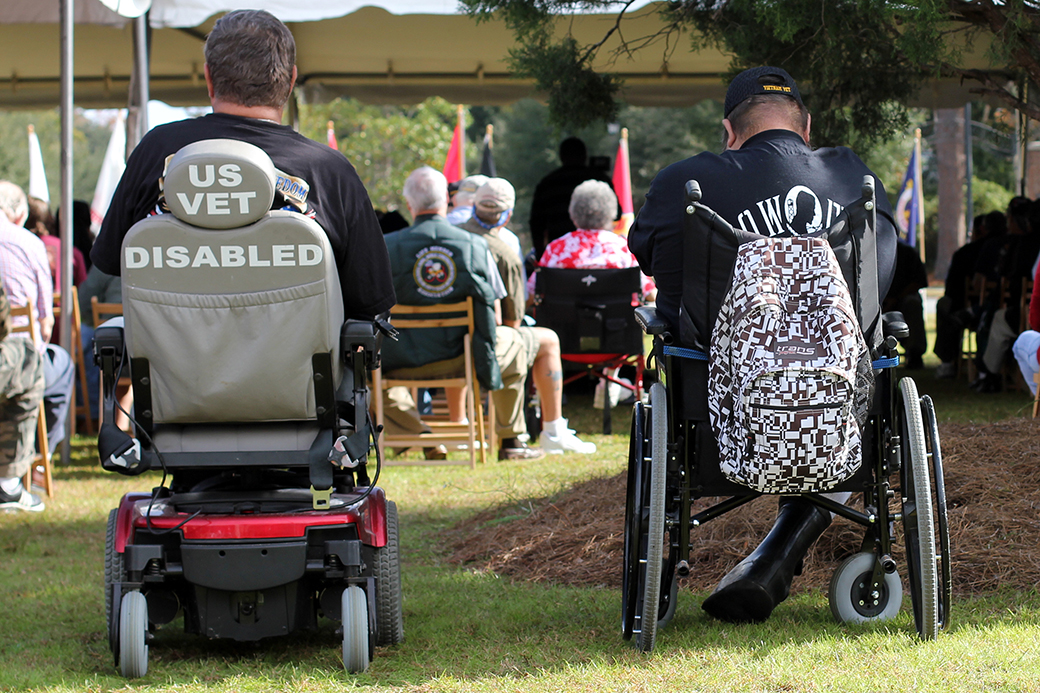
The City of North Charleston, South Carolina hosted its annual Veterans Day tribute at Park Circle on November 12, 2012. (Photo: Ryan Johnson/flickr CC 2.0)
The devastating wounds that have caused Americans such pain were self-inflicted. We fought wars that should never have been fought. We allowed giant banks and predatory corporations to plunder the nation’s wealth and resources without regard for the damage done to the economy, the environment or the people. We neglected the nation’s physical infrastructure to the point where bridges were collapsing, water systems were failing, and the historic city of New Orleans was submerged in a catastrophic flood that shocked not just the nation but the world.
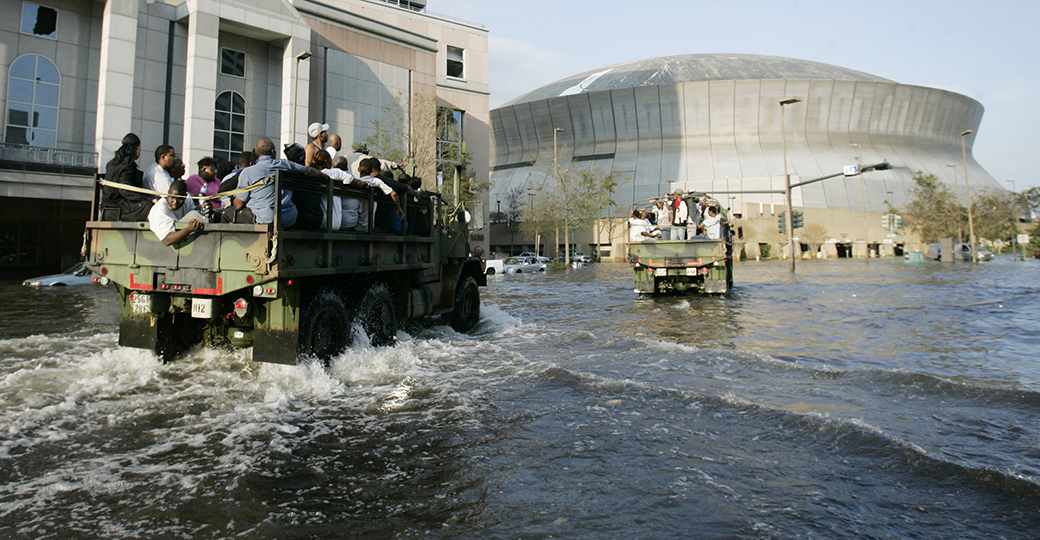
National Guard trucks haul residents through flood waters to the Superdome after their neighborhoods were flooded when Hurricane Katrina hit New Orleans, Louisiana in the summer of 2005. (AP Photo/Eric Gay)
The abiding premise of this book is that things do not have to be this way. There is no reason to sit still for an intolerable status quo. Democracy is still alive, if not particularly healthy, in America. Ordinary citizens can still roll up their sleeves and – with enough effort, commitment and willingness to sacrifice – reclaim their nation’s lost promise. The dream can still be revived. Wounds can heal. A fresh start can be made. But only if citizens overcome their reluctance to engage in collective civic action on an organized and sustained basis. In other words, only if ordinary citizens choose to intervene aggressively and courageously in their own fate.
My goal in this book is to get beyond the din of clueless politicians and nonstop talking heads and show what really happened, how we got into such a deep fix and how we can get out of it. Like a print in an old-fashioned darkroom, a clearer portrait of America will emerge. We’ll see the great challenges facing the nation from the perspective of the ordinary individuals and families who are directly affected by them – a young Army captain who was badly wounded in Afghanistan, a woman who was driving across the Interstate-35 Bridge in Minneapolis when it collapsed into the Mississippi River, young people trying to cope with staggering amounts of student debt in the worst economic environment since the Great Depression. I’ve focused most intently on four specific areas: the employment crisis, which was badly underestimated and poorly understood; the need to rebuild and modernize the nation’s infrastructure and the relationship of that vast project to employment; the critical task of revitalizing the public schools in a way that meets the profound educational imperatives of the 21st century; and the essential obligation that we have as rational and civilized beings to stop fighting pointless and profoundly debilitating wars.
There will be subtexts that weave their way through these interrelated themes, especially the poisonous effects of wealth and income inequality. And I’ll trace the relevant history that brought us to the present troubled moment. But there won’t be any suggestion that there are neat and tidy solutions to the crises facing America. We don’t need another ten or twelve-point plan. There are good ideas all over the place, even great ideas. But none of them have a prayer of working if the citizenry is not somehow aroused to reclaim America from the powerful moneyed interests – the “malefactors of great wealth,” as Teddy Roosevelt so memorably called them – who have been the ones most responsible for driving the nation into such a wretched state of affairs. The historian Howard Zinn once told me, “If there is going to be change, real change, it will have to work its way from the bottom up, from the people themselves. That’s how change happens.”
All of the great movements in America – from abolition and civil rights, to the labor and women’s movements and the fight for gay rights – all were led by citizens fed up with an intolerable status quo. That is how societies change. That is how America can, should, and – with the proper commitment and cooperative spirit – will change.
Excerpted from Losing Our Way by Bob Herbert. © 2014 by Bob Herbert. By permission of Doubleday, a division of Penguin Random House, Inc. All rights reserved. No part of this excerpt may be reproduced or reprinted without permission in writing from the publisher.


